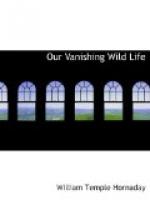At this juncture, a brief survey of the attitude toward wild life of certain American institutions of national reputation will be decidedly pertinent. I shall mention only a few of the many that through their character and position owe specific duties to this cause. Noblesse oblige!
* * * * *
The Biological Survey of the U.S. Department of Agriculture is a splendid center of activity and initiative in the preservation of our wild life. The work of Dr. T.S. Palmer has already been spoken of, and thanks to his efforts and direction, the Survey has become the recognized special champion of preservation in America.
The U.S. Forestry Bureau is developing into a very valuable ally, and we confidently look forward to the time when its influence in preservation will be a hundred times more potent than it is to-day. That will be when every national forest is made a game preserve, and every forest ranger is made a game warden. Let us have both those developments, and quickly.
In 1896 the AMERICAN MUSEUM OF NATURAL HISTORY became a center of activity in bird protection, and the headquarters of the New York State Audubon Society. The president of the Museum (Professor Henry Fairfield Osborn) is also the president of that organization.
In several of the New York State movements for bird conservation, especially those bearing on the plumage law, the American Museum has been active, and at times conspicuous. No one (so I believe) ever appealed to the President of the Museum for help on the firing line without receiving help of some kind. Unfortunately, however, the preservation of wild life is not one of the declared objects of the American Museum corporation, or one on which its officers may spend money, as is so freely and even joyously done by the Zoological Society. The Museum’s influence has been exerted chiefly through the active workers of the State Audubon Society, and it was as president of that body that Professor Osborn subscribed to the fund that was so largely instrumental in creating the New York law against the sale of game.
There is room for an important improvement in the declared objects of the American Museum. To the cause of protection it is a distinct loss that that great and powerful institution should be unable to spend any money in promoting the preservation of our fauna from annihilation. An amendment to its constitution is earnestly recommended.
The activities of the NEW YORK ZOOLOGICAL SOCIETY began in 1896, and they do not require comment here. They have been continuous, aggressive and far-reaching, and they have been supported by thousands of dollars from the Society’s treasury. It is true that the funds available for protection work have not represented a great annual sum, such as the work demands, but the amount being expended from year to year is steadily increasing. In serious emergencies there is always something available! During the past two years, to relieve the Society of a portion of this particular burden, the director of the Park secured several large subscriptions from persons outside the Society, who previously had never entered into this work.




